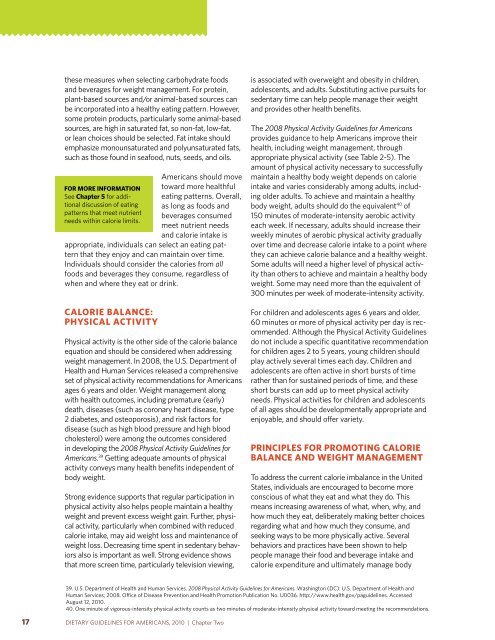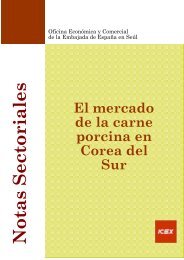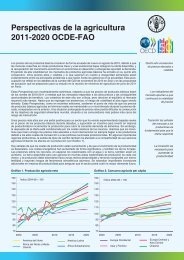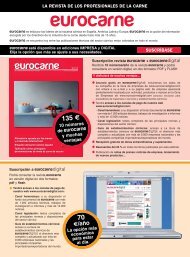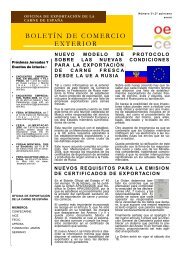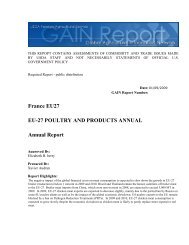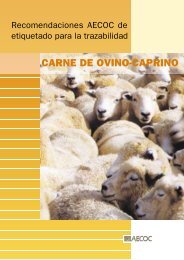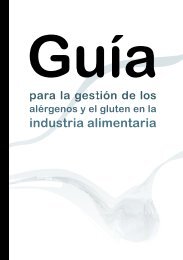Dietary Guidelines for Americans - SchoolNutritionAndFitness.com
Dietary Guidelines for Americans - SchoolNutritionAndFitness.com
Dietary Guidelines for Americans - SchoolNutritionAndFitness.com
- No tags were found...
You also want an ePaper? Increase the reach of your titles
YUMPU automatically turns print PDFs into web optimized ePapers that Google loves.
these measures when selecting carbohydrate foodsand beverages <strong>for</strong> weight management. For protein,plant-based sources and/or animal-based sources canbe incorporated into a healthy eating pattern. However,some protein products, particularly some animal-basedsources, are high in saturated fat, so non-fat, low-fat,or lean choices should be selected. Fat intake shouldemphasize monounsaturated and polyunsaturated fats,such as those found in seafood, nuts, seeds, and oils.<strong>for</strong> More in<strong>for</strong>MationSee chapter 5 <strong>for</strong> additionaldiscussion of eatingpatterns that meet nutrientneeds within calorie limits.<strong>Americans</strong> should movetoward more healthfuleating patterns. Overall,as long as foods andbeverages consumedmeet nutrient needsand calorie intake isappropriate, individuals can select an eating patternthat they enjoy and can maintain over time.Individuals should consider the calories from allfoods and beverages they consume, regardless ofwhen and where they eat or drink.calorie Balance:Physical activityPhysical activity is the other side of the calorie balanceequation and should be considered when addressingweight management. In 2008, the U.S. Department ofHealth and Human Services released a <strong>com</strong>prehensiveset of physical activity re<strong>com</strong>mendations <strong>for</strong> <strong>Americans</strong>ages 6 years and older. Weight management alongwith health out<strong>com</strong>es, including premature (early)death, diseases (such as coronary heart disease, type2 diabetes, and osteoporosis), and risk factors <strong>for</strong>disease (such as high blood pressure and high bloodcholesterol) were among the out<strong>com</strong>es consideredin developing the 2008 Physical Activity <strong>Guidelines</strong> <strong>for</strong><strong>Americans</strong>. 39 Getting adequate amounts of physicalactivity conveys many health benefits independent ofbody weight.Strong evidence supports that regular participation inphysical activity also helps people maintain a healthyweight and prevent excess weight gain. Further, physicalactivity, particularly when <strong>com</strong>bined with reducedcalorie intake, may aid weight loss and maintenance ofweight loss. Decreasing time spent in sedentary behaviorsalso is important as well. Strong evidence showsthat more screen time, particularly television viewing,is associated with overweight and obesity in children,adolescents, and adults. Substituting active pursuits <strong>for</strong>sedentary time can help people manage their weightand provides other health benefits.The 2008 Physical Activity <strong>Guidelines</strong> <strong>for</strong> <strong>Americans</strong>provides guidance to help <strong>Americans</strong> improve theirhealth, including weight management, throughappropriate physical activity (see Table 2-5). Theamount of physical activity necessary to successfullymaintain a healthy body weight depends on calorieintake and varies considerably among adults, includingolder adults. To achieve and maintain a healthybody weight, adults should do the equivalent 40 of150 minutes of moderate-intensity aerobic activityeach week. If necessary, adults should increase theirweekly minutes of aerobic physical activity graduallyover time and decrease calorie intake to a point wherethey can achieve calorie balance and a healthy weight.Some adults will need a higher level of physical activitythan others to achieve and maintain a healthy bodyweight. Some may need more than the equivalent of300 minutes per week of moderate-intensity activity.For children and adolescents ages 6 years and older,60 minutes or more of physical activity per day is re<strong>com</strong>mended.Although the Physical Activity <strong>Guidelines</strong>do not include a specific quantitative re<strong>com</strong>mendation<strong>for</strong> children ages 2 to 5 years, young children shouldplay actively several times each day. Children andadolescents are often active in short bursts of timerather than <strong>for</strong> sustained periods of time, and theseshort bursts can add up to meet physical activityneeds. Physical activities <strong>for</strong> children and adolescentsof all ages should be developmentally appropriate andenjoyable, and should offer variety.PrinciPles <strong>for</strong> ProMoting calorieBalance and weight ManageMentTo address the current calorie imbalance in the UnitedStates, individuals are encouraged to be<strong>com</strong>e moreconscious of what they eat and what they do. Thismeans increasing awareness of what, when, why, andhow much they eat, deliberately making better choicesregarding what and how much they consume, andseeking ways to be more physically active. Severalbehaviors and practices have been shown to helppeople manage their food and beverage intake andcalorie expenditure and ultimately manage body39. U.S. Department of Health and Human Services. 2008 Physical Activity <strong>Guidelines</strong> <strong>for</strong> <strong>Americans</strong>. Washington (DC): U.S. Department of Health andHuman Services; 2008. Office of Disease Prevention and Health Promotion Publication No. U0036. http://www.health.gov/paguidelines. AccessedAugust 12, 2010.40. One minute of vigorous-intensity physical activity counts as two minutes of moderate-intensity physical activity toward meeting the re<strong>com</strong>mendations.17DIETARY GUIDELINES FOR AMERICANS, 2010 | Chapter Two


